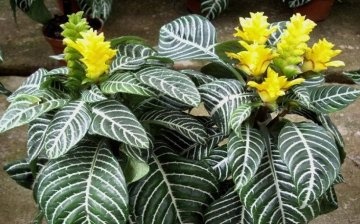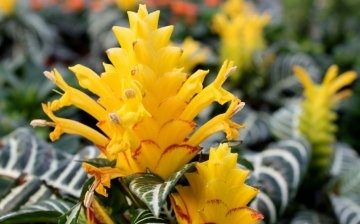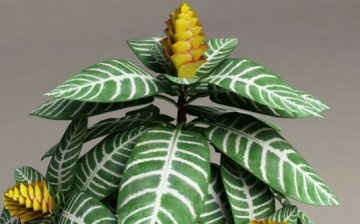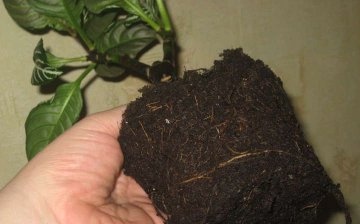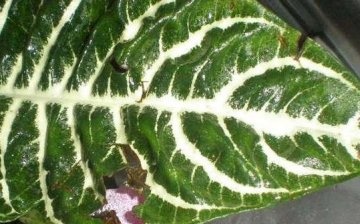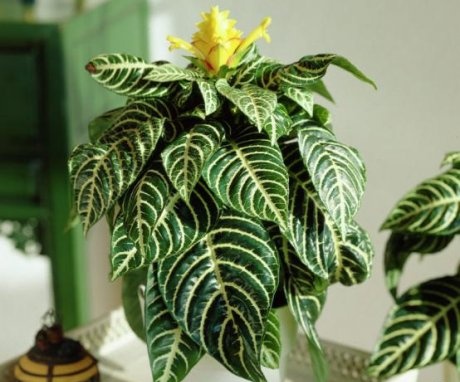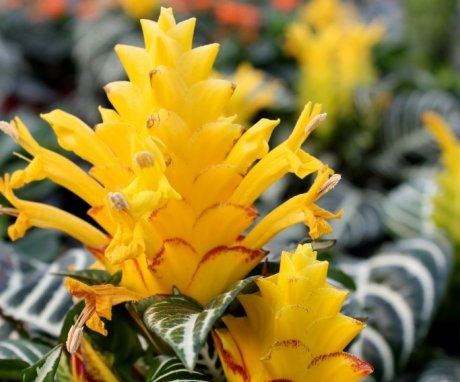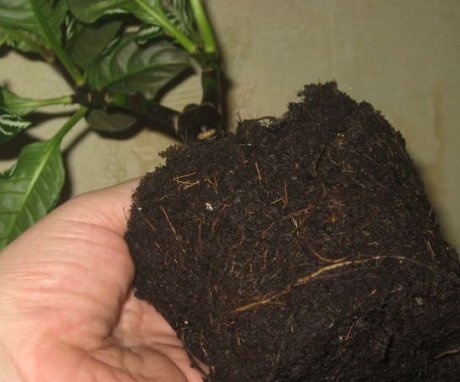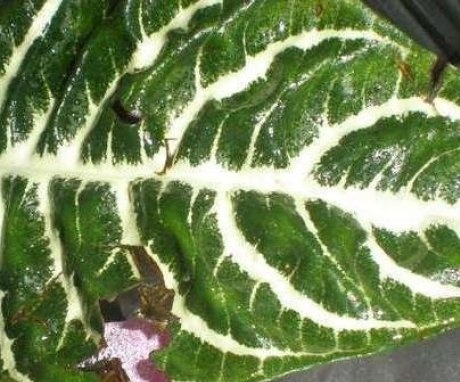Afelandra: proper flower care
Afelandra is a fast growing evergreen plant. The genus is represented by shrubs, half-shrubs and grasses up to 2 m high. The leaves are corrugated, with a smooth or prickly surface, variegated in color. The leaf plate is lined with silvery-white lines, forming an ornament.
The flowers form tetrahedral inflorescences in the form of an ear or pineal shape, up to 15 cm. The flowers bloom yellow, red, orange, with a two-lipped corolla, pistil and four stamens. Corolla from yellow to lilac. Blooms for 2-3 months. Fruits in the form of boxes with two seeds. They form by February if the wilted flowers are not removed.
Content:
- Indoor flower description
- We create optimal microclimate parameters
- Water and feed correctly
- Transplant: we comply with the terms and rules
- Diseases and pests: methods of dealing with them
Indoor flower description
Representatives of home floriculture are: Afelandra orange and protruding Afelandra:
- Aphelandra golden or orange (Aphelandra aurantiaca). It grows in Mexico and Central America. Low-growing shrub. Thick stem with red tint. Leaves are egg-shaped, silvery-green, smooth, up to 25 cm long. Inflorescence is a tetrahedral spike, up to 10-15 cm high, bright orange, with green inflorescences. Blooms no more than 7 days.
- Protruding aphelandra (Aphelandra squarrosa). Imported from Central America. Low bush with bare fleshy shoots of reddish color. Has variegated highly decorative leaves. They are located opposite, ovoid-epileptic in shape. The surface of the leaf plate is lined with silvery-white stripes. The inflorescence is spike-shaped, tetrahedral, 30 cm long. Orange bracts adorn the bright yellow flowers. Blooms from May to November.
We create optimal microclimate parameters
Afelandra is capricious and painstaking caring for her. Flower pots are placed in optimal growth conditions for her:
- Lighting... Placed mainly on the western or eastern windows. On the southern window, the flower is darkened from 11:00 to 17:00, in order to avoid burning the leaves. In the summer they are taken out into the street, but sheltered from precipitation and drafts. It is possible to do with regular airing of the room. Since autumn, they are additionally illuminated with fluorescent lamps lasting from 8 hours. They are placed at a height of 70 cm from the plant. If the backlight is ignored, the plant will stretch out and not bloom.
- Temperature conditions. The plant is thermophilic. Requires optimal room temperature throughout the year up to 25 ° C. A short drop in temperature to 16 ° C will tolerate, without consequences, prolonged cold cannot stand. For the winter, they transfer it to a cool room (+ 18 ° C).
- Air humidity. Afelandra is sprayed daily with warm, settled water from a fine spray. During flowering, spraying is carried out once a decade.
Also place the flower pot in a container with a damp sawdust (peat, expanded clay, pebbles), or place a humidifier nearby.
Water and feed correctly
Important! Not a drop of water should fall on the leaves. This is fraught with the development of a putrefactive process. Watered only with soft water.It is boiled and cooled, or previously frozen is thawed. The water is heated to room temperature and watered: in winter - once a week, the rest of the time - three times a week. In the warm season, water is plentifully, in the cold season, they moisten the soil, preventing overdrying.
Top dressing consists of applying fertilizer twice a month.
In winter, feeding is excluded. The abundance of flowering reduces the excess of nitrogen-containing fertilizers. Their lack slows down the formation of inflorescences, imparts a yellow-orange color to the foliage. Without phosphorus, Afelandra does not bloom, the flowers become smaller, their color fades. Potassium provides intensity of color of leaves, resistance of shoots. With its lack, the number of leaves is reduced. The use of fertilizers is essential.
The following are suitable for Afelandra:
- Agricola consists of nitrogen, potassium, phosphorus, magnesium, trace elements that are used by the plant for full growth and formation. The preparation contains dietary supplements (energens) that strengthen the flower's immunity, increasing resistance to diseases and pests, and stimulating the growth function. Sold a liquid concentrate, a dry substrate of granules and sticks.
- Bona Forte. Universal liquid fertilizer. Provides complete, balanced nutrition, increases decorative effect, imparts rich color to the leaves, prolongs the period flowering.
- Bona Forte "Adaptation" helps the plant during the period after purchase and before the start of active growth, as well as during transplantation, to maintain decorativeness and not die. A change in temperature, lighting, watering, drafts is stress for the plant. Bona Forte "Adaptation" increases stress resistance. They are fed for 2 months.
Transplant: we comply with the terms and rules
First, determine the size of the pot. Its maximum diameter does not exceed 13 cm. In a larger pot, the plant will stretch out and lose its decorative effect. They are planted in a specially prepared soil mixture:
- mix sand, peat, clay - sod land (1: 1: 2)
- take a deciduous-peat mixture and sand (3: 1)
- deciduous - sod land, peat, sand, humus go into the soil mixture (4: 1: 1: 1)
It is recommended to add charcoal to the soil. It prevents decay root system and fungal diseases. They are engaged in transplanting in the spring. Young plants need it annually. In the process, damage to the root system is eliminated. Adult afelandras are transplanted every 4 years.
When buying a plant in a store, they clarify the composition of the soil mixture in a pot. In the future, this composition is observed. In a familiar soil, it is easier for a flower to adapt to new conditions of existence.
With a decrease in decorative qualities, they are returned by rooting cuttings. For them, the tops of a plant or young shoots, up to 15 cm long, are suitable. They are treated with growth stimulants, rooted in wet peat (sand), cover the pot with polyethylene or glass. The root system will form in 1-2 months.
Diseases and pests: methods of dealing with them
Diseases of Afelandra:
- Foliage flies. Reasons: lack of moisture leads to drying of the root system; decrease in room temperature, drafts; intense sunlight.
- The edges of the leaves have turned brown. Causes: low air humidity, leaf mold, sunburn, lack of fresh air.
- The flower fades. Reasons: constant and prolonged exposure to a draft.
Pests include:
- Shield. The scutellum is a small parasite with an oval body covered with a wax shield. Its size is 2 mm. It leaves a sticky substance on the leaves and stems, in which a sooty fungus grows (the leaf looks like it is smeared with soot). It coats the leaf, clogging up the pores, which interferes with the process of photosynthesis. The leaf turns yellow and falls off.
-
False shield - differs from the shield with a flat shield. They resemble specks on leaves. It sucks out the juice, and injects a poisonous liquid into the formed voids, which slows down photosynthesis. This is how red-brown spots are formed.If the plant is left untreated, the leaves will deform and dry out.
A distinctive feature of parasitizing scale insects is soil blackening. Control measures: The affected flower is isolated. Plants that stood next to him are treated with soapy water, then with an insecticidal preparation. A cotton swab pre-moistened with an insecticide removes pests. A diseased specimen is wiped with a tobacco solution, then the solution is washed off with clean water. The dried plant is treated with an insecticide and covered with polyethylene for 30 minutes. After 2 days, the dead pests and the remnants of the drug are washed off with warm water.
- Mealy worm is a sucking pest, oval in shape, 3-7 mm. It is covered with a white coating, has white and pink bristles on the sides. Produce a white, sticky mucus that interferes with gas exchange in the flower. The plant appears to be dusted with flour. Control measures: Remove clutches of eggs and pests with a cotton swab. Prepare a mixture: 2 tbsp. vodka and 1 liter of soapy water. They are treated with a mixture and then with a pesticide.
-
A spider mite is a small arachnid insect. White, brown, red. It multiplies at lightning speed. Lives on the lower surface of the leaf, gnaws at the surface and sucks out cell sap. White spots form on the leaf, loses color, fades and falls off. A tick entangles the plant with a woven web.
Control measures: Destroy with acaricidal agents. The treatment is carried out on the street (due to the toxicity of the drug) by spraying or dipping into a container with a solution, three times with an interval of 5 days.
- Aphid - small pests 2-7 mm in size. Most often green. It pierces the surface of shoots and leaves with a proboscis, sucking juices from them. The flower fades.
Aphid control measures:
- aphids are washed off the plant by placing the ground part under the shower
- the purchased flower is transplanted into fresh soil
- spray with water tincture of tobacco (40 g per 1 liter of water)
- treated with celandine tincture (300 g per 1 l)
- use chopped tomato tops. It is poured with water (400 g per 1 l), boiled for 30 minutes, 4 g of soap is added
More information can be found in the video:
The attractiveness of Afelandra is due to the bracts. It is used as an element of interior decoration, flower exhibitions and winter gardens. It is an irreplaceable component of compositions with exotic plants.
But as beautiful as she is, so useful. In Japan, the leaves of this beauty are known for folk medicine. They are used to treat thermal skin lesions. And the contemplation of the rich green attractive foliage makes the prognosis for the treatment of neuralgia favorable, increases the body's resistance to stress.



